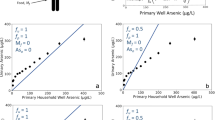Abstract
Within the context of the National Human Exposure Assessment Survey (NHEXAS), metals were evaluated in the air, soil, dust, water, food, beverages, and urine of a single respondent. Potential doses were calculated for five metals including arsenic. In this paper, we seek to validate the potential dose calculations through spatial analysis of the data. Others report elevated arsenic concentrations in biological and environmental samples from residents of mining towns, particularly Ajo, Arizona. These reports led us to expect potential arsenic doses above the 90th percentile of the NHEXAS exposure distribution to be from residents of mining communities. Arsenic dose was calculated using media concentrations, time activity patterns, and published exposure factors. Of the 179 homes evaluated, 54 were in mining communities; 11 of these were considered separately for reasons of population bias. Of the 17 homes with the greatest potential arsenic doses, almost half (47%) were in mining communities. We evaluated the potential doses by media from nonmining and mining areas using the nonparametric Mann–Whitney U test. Statistically significant (p=0.05) differences were found between mining (n=43) and nonmining sites (n=122) for total exposure and for each of the following media: house dust, yard soil, outdoor air, beverage consumed, and water consumed. No differences were found in either food or indoor air of mining and nonmining areas. We eliminated outliers and repeated the test for all media; significance increased. Dietary, organic arsenic from fish consumption contributed to elevated arsenic exposure among people from nonmining communities and acted as an initial confounder. When controlling for fish consumption, we were able to validate our potential dose model using arsenic, particularly in Ajo. Further, we identified three mining communities lacking elevated arsenic exposure. Additional work is needed speciating the arsenic and evaluating health risks. The utilization of Geographic Information System facilitated spatial this project and paves the way for more sophisticated future spatial analyses.
This is a preview of subscription content, access via your institution
Access options
Subscribe to this journal
Receive 6 print issues and online access
$259.00 per year
only $43.17 per issue
Buy this article
- Purchase on Springer Link
- Instant access to full article PDF
Prices may be subject to local taxes which are calculated during checkout
Similar content being viewed by others
Author information
Authors and Affiliations
Corresponding author
Rights and permissions
About this article
Cite this article
O'ROURKE, M., ROGAN, S., JIN, S. et al. Spatial distributions of arsenic exposure and mining communities from NHEXAS Arizona. J Expo Sci Environ Epidemiol 9, 446–455 (1999). https://doi.org/10.1038/sj.jea.7500050
Published:
Issue Date:
DOI: https://doi.org/10.1038/sj.jea.7500050
Keywords
This article is cited by
-
Contribution of arsenic and uranium in private wells and community water systems to urinary biomarkers in US adults: The Strong Heart Study and the Multi-Ethnic Study of Atherosclerosis
Journal of Exposure Science & Environmental Epidemiology (2023)
-
Contribution of diet to aggregate arsenic exposures—An analysis across populations
Journal of Exposure Science & Environmental Epidemiology (2014)
-
Measured versus modeled dietary arsenic and relation to urinary arsenic excretion and total exposure
Journal of Exposure Science & Environmental Epidemiology (2013)
-
Arsenic uptake and speciation in vegetables grown under greenhouse conditions
Environmental Geochemistry and Health (2009)
-
Comparison of global positioning system (GPS) tracking and parent-report diaries to characterize children's time–location patterns
Journal of Exposure Science & Environmental Epidemiology (2007)



